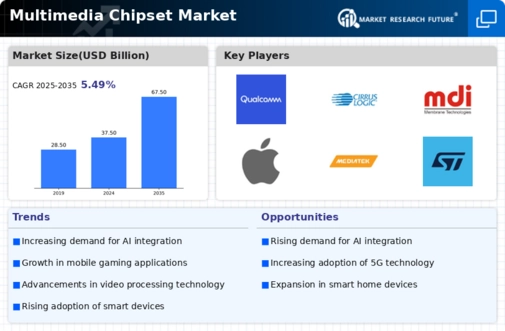Market Analysis
In-depth Analysis of Multimedia Chipset Market Industry Landscape
The Multimedia Chipset Market is propelled by a dynamic interplay of technological advancements, consumer preferences, and industry trends. Multimedia chipsets are integral components in electronic devices, enabling efficient processing of audio, video, and graphics. The market dynamics are significantly influenced by the rapid evolution of multimedia technologies and the increasing demand for enhanced multimedia experiences.
One of the key drivers shaping the market dynamics is the continual advancement in multimedia capabilities. Consumers today expect seamless multimedia experiences with high-quality audio and visuals. This demand is particularly evident in the gaming, streaming, and content creation sectors. As a result, multimedia chipset manufacturers are under constant pressure to develop chipsets that can handle complex multimedia tasks, such as real-time video encoding and decoding, immersive audio processing, and graphics rendering for high-resolution displays.
The proliferation of multimedia-rich applications across diverse industries is another major factor driving market dynamics. From smartphones and tablets to smart TVs and automotive infotainment systems, the integration of multimedia chipsets is expanding across a wide range of devices. This diversification of applications fuels the demand for versatile multimedia chipsets capable of meeting the unique requirements of each industry. For instance, automotive multimedia chipsets may prioritize robustness and reliability, while gaming-focused chipsets emphasize high-performance graphics and low-latency audio processing.
Cost considerations play a pivotal role in market dynamics, especially in consumer electronics markets. Manufacturers aim to strike a balance between delivering advanced multimedia capabilities and maintaining cost-effectiveness. This is essential to meet the demands of price-sensitive consumers while providing a competitive edge in the market. Advancements in semiconductor manufacturing technologies contribute to cost efficiency, enabling manufacturers to produce multimedia chipsets with improved performance at reasonable prices.
Competition within the multimedia chipset market is intense, with both established players and emerging companies vying for market share. Differentiation is a key strategy, with companies focusing on unique features, power efficiency, and compatibility with the latest multimedia standards. Strategic partnerships and collaborations are common as companies seek to enhance their product portfolios and expand their market presence.
Regulatory compliance and industry standards also influence market dynamics. Adherence to multimedia standards, such as HDMI, USB, and audio codecs, is crucial for ensuring compatibility and interoperability across devices. Manufacturers need to stay abreast of evolving standards and regulations to meet the expectations of both consumers and industry stakeholders.
Environmental considerations and sustainability have become increasingly important factors in market dynamics. Manufacturers are pressured to develop energy-efficient multimedia chipsets and adhere to eco-friendly practices. This shift aligns with global efforts to reduce electronic waste and minimize the environmental impact of electronic devices.
Consumer preferences and trends exert a significant influence on the multimedia chipset market. The demand for higher resolution displays, immersive audio experiences, and support for emerging technologies like virtual reality (VR) shapes the features and specifications that consumers seek in their devices. Multimedia chipset manufacturers need to anticipate and adapt to these trends to remain competitive and relevant in the rapidly evolving consumer electronics landscape.
The chances for more growth in the global multimedia chipset market come from the introduction of a toolkit for Alexa voice service development. This is expected to enhance smart speakers and applications for smart homes. These smart services include hands-free portable speakers, voice-controlled devices, and networked speakers. Since all these speakers need multimedia chipsets, it presents a significant opportunity for the development of the multimedia chipset market.









Leave a Comment